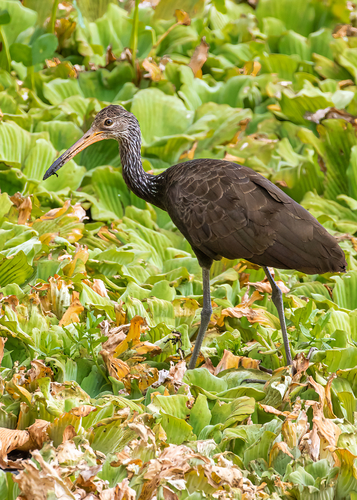
Limpkin
The Limpkin (*Aramus guarauna*) is a unique bird, the sole member of the family Aramidae. It is often mistaken for a crane or an ibis, but it occupies a unique evolutionary niche. Found primarily in wetlands across the Americas, the Limpkin plays an important ecological role as a specialized predator of apple snails. Its distinctive, wailing call is a characteristic sound of its habitat, and the bird's name is derived from its seemingly limping gait. The Limpkin holds no significant widespread cultural status.
56-71 cm
Length
101-107 cm
Wingspan
Least Concern
Conservation Status
Distribution
The Limpkin's range extends from Florida and southern Georgia in the United States, through the Caribbean, Mexico, and Central America, down to South America as far south as Argentina. They are generally non-migratory, but may move locally in response to water level changes.
Lifespan
The lifespan in the wild is not well documented, but likely exceeds 10 years. Captive individuals have been known to live longer.
Limpkin's Habitat
Habitat Types
Freshwater marshes, Swamps, Mangrove swamps, Wetlands with dense vegetation, Slow-moving rivers and streams
Climate Zones
Tropical, Subtropical, Warm Temperate
Adaptations
Limpkins have long toes that help them distribute their weight and walk on floating vegetation. Their slightly curved bill is adapted for extracting snails from their shells.
Variations
Several subspecies are recognized, differing slightly in size and plumage coloration. For example, *A. g. guarauna* is found in South America, while *A. g. pictus* occurs in Florida and the Caribbean.
Appearance
Breeding Plumage
Plumage is generally similar year-round.
Seasonal Feather Changes
Minimal seasonal variation.
Sex Based Plumage Differences
Males and females have similar plumage.
Notable Features
Long, slightly decurved bill, Dark brown plumage with white streaks and spots, Long, dark legs, White spotting most prominent on the neck and back
Diet and Feeding
Primary Foods
Apple snails (Pomacea spp.), Other aquatic snails, Mussels, Insects, Crustaceans, Frogs (occasionally)
Foraging Behavior
Limpkins typically forage by wading in shallow water, probing the mud and vegetation with their bill. They visually locate prey and use their specialized bill to extract snails from their shells.
Specializations
The Limpkin's bill has a slight curve and a specialized tip that allows it to efficiently remove snails from their shells without crushing them.
Seasonal Diet Variations
Diet may shift slightly depending on the availability of apple snails, with other prey becoming more important when snails are scarce.
Behavior
Social Structure
Limpkins are generally solitary or found in pairs, but may gather in small groups at abundant food sources. They are not highly social.
Communication
Loud, wailing calls (often described as a scream or cry), Rattling calls, Bill snapping (during courtship or aggressive encounters)
Migration
Largely non-migratory, but may undertake local movements in response to changing water levels or food availability.
Territorial or Group Behaviors
Limpkins are territorial during the breeding season, defending their nesting area from intruders. Outside of breeding, they are generally less aggressive.
Conservation
Threats
Habitat loss and degradation (due to drainage of wetlands, agriculture, and development), Water pollution, Pesticide use (which can affect their snail prey), Hunting (in some areas)
Protection Programs
Wetland conservation and restoration efforts, Protection under the Migratory Bird Treaty Act (in the United States)
Local National Laws
Protected in many countries within its range.
Population Trend
Stable
Population Estimates
The global population is estimated to be between 500,000 and 4,999,999 individuals.
Interesting Facts
The Limpkin's call is often used in movies to represent the sound of a jungle or swamp.
The distinctive, eerie call is highly evocative of wetland environments.
Limpkins are sometimes called the 'crying bird' due to their mournful calls.
The name reflects the vocalization's resemblance to a human cry.
Limpkins can sometimes be seen 'dancing'
This behavior involves rapid foot movements that stir up the substrate, potentially helping them locate prey.
Faqs about Limpkin
Are Limpkins related to cranes?
While they share some physical similarities with cranes, Limpkins are in their own unique family (Aramidae) and are not closely related to cranes (Gruidae).
What is the purpose of the white spots on a Limpkin's plumage?
The white spots and streaks likely provide camouflage in the dappled light of their wetland habitat.
Do Limpkins eat anything besides apple snails?
While apple snails are their primary food source, Limpkins also eat other snails, mussels, insects, and occasionally frogs and crustaceans.
Copyright @ Nature Style Limited. All Rights Reserved.
 English
English